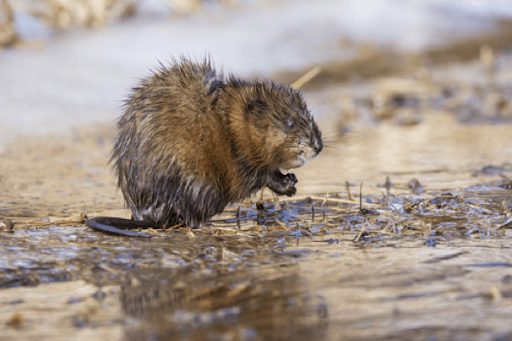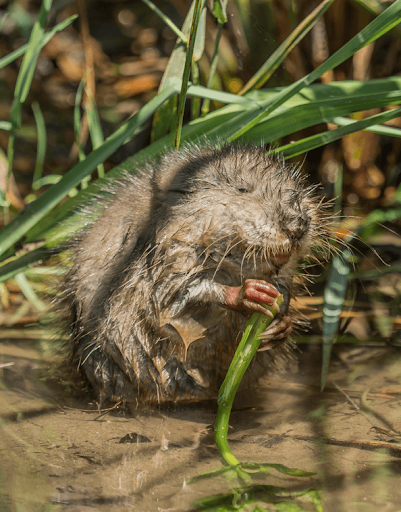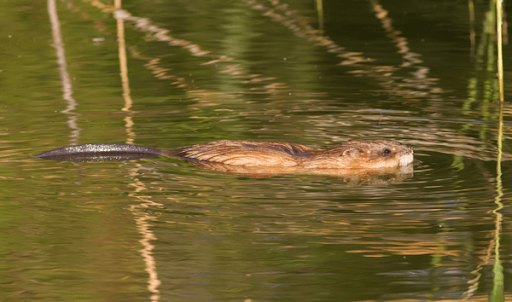How to Get Rid of Muskrats
Do you have a muskrat problem near your property? Schedule a muskrat control service today!

Muskrat Control Done Right
Muskrats are vital to the ecosystem and wildlife balance. But this doesn’t mean you want them wreaking havoc on your property.
The expert team at Varment Guard can perform ecologically-sensitive and effective muskrat removal and prevention.
To learn more about our wildlife removal services, take a look at our Wildlife Removal & Trapping page.
What are Muskrats? And Why are They a Problem?
Scientific Name: Ondatra zibethicus
Muskrats are semi-aquatic rodents commonly found throughout the Midwest, including Indiana, Michigan, Ohio, and Minnesota, as well as other parts of North America.
Despite their name, muskrats are not true rats—they belong to a different rodent family and are known for their thick brown fur, long hairless tails, and strong swimming abilities. These herbivores primarily live in wetlands, where they build dome-shaped lodges or burrows along pond and river banks. Muskrats spend most of their time in or near water, feeding on aquatic vegetation and raising their young in well-hidden shelters.
Muskrat Pest Status: Why are Muskrats a Problem?
Muskrats are considered pests not just because of their presence, but because of the costly damage they cause to both residential and commercial properties. They frequently burrow into the banks, shorelines, dams, and levees of ponds and reservoirs, which can weaken structural integrity and lead to erosion or flooding.
In urban areas, muskrats may feed on ornamental plants and landscaping, while in agricultural settings, they can damage crops near water sources. Their tunneling and feeding behaviors make them a persistent and destructive nuisance, especially when left unmanaged.
MUSKRAT BIOLOGY
- Adult body length (without tail): 8 to 18 inches
- Adult body weight: 1 1/2 to 5 pounds
- Gestation period: 22 to 30 days
- Litters per year: 2 to 3
- Litter size: 1 to 15 young (usually 4 to 8)
- Breeding season: February through August
- Birthing season: March through September
- Age at which young are weaned: 4 weeks
- Activity period: Night: pre-sunset through post-dawn
- Range: 1 to 9 acres
- Primary foods: Herbaceous and aquatic plants, grasses, crops and legumes
Muskrat Diet & Characteristics
Muskrats eat roots, stems, leaves, and fruits from many water and land plants. These plants include cattails, water lilies, decorative plants, and garden vegetables.
Along with plants, the muskrat also consumes small fish, clams, snails, and even turtles. The muskrat’s main predators are mink and otters. Some more muskrat predators include:
- Hawks
- Eagles
- Owls
- Ospreys
- Foxes
- Coyotes
- Raccoons
How to Get Rid of Muskrats: Professional Wildlife Control
1. Reduce Water Level
Muskrat-infested ponds can be cleared of these animals and rendered less habitable by drawing the water level down 2 to 3 feet below normal levels during winter. This will expose dens, burrows and runs so they can be filled in with stone. Dams and levees will also be exposed so they can be reinforced (by rip-rapping) with stone after fumigation. Any reopened holes should be retreated.
2. Lethal- And Live-Trapping
Leg-hold traps (No. 1, 1 ½ or 2 long spring or coil spring) are frequently used in drowning sets. Body-grip traps are very effective when placed strategically (e.g., den entrances, trails, feed beds and other frequented sites) in underwater and shoreline sets. Small wire-mesh suitcase traps are effective for trapping muskrats underwater; these are lethal by drowning.
Trapping muskrats helps keep these prolific animals in balance and prevents damage to lake seawalls, river banks, and retention ponds.


Effective Muskrat Control with Varment Guard
Muskrats are persistent, which means preventing and removing them takes a lot of effort. That’s why it’s best to hire a professional wildlife control team, like Varment Guard, to deal with your muskrat problem.
Ready to get started with our humane muskrat control services? Contact Varment Guard today!
We can rid you of muskrats safely and efficiently!
Frequently Asked Questions
Woodchuck vs Muskrat: What’s The Difference?
Woodchucks (groundhogs) and muskrats are both rodents, but they differ in size, habitat, and behavior. Woodchucks are larger, land-dwelling animals typically found in open woodlands, fields, and suburban areas, where they dig burrows and feed on a wide variety of plants. They have short, furry tails and robust bodies. In contrast, muskrats are smaller, semi-aquatic rodents that live in wetlands such as ponds, marshes, and rivers. They have long, hairless tails and primarily eat aquatic vegetation. While woodchucks are known for their burrowing on land, muskrats are often seen swimming and building lodges in or near water.
When are Muskrats Most Active?
Muskrats are most active during dawn and dusk. They’re crepuscular animals, meaning they prefer low-light conditions, and are often seen swimming or foraging during early morning or evening hours. Activity tends to increase in spring and fall, especially during breeding and feeding seasons, when they’re more likely to cause noticeable damage around ponds and wetlands.
What Do Muskrats Eat?
Muskrats are herbivores that primarily feed on aquatic vegetation such as cattails, water lilies, and duckweed. They may also eat small aquatic animals like frogs or mussels when plant food is scarce.
How Do You Get Rid of Muskrats? Do DIY Measures Work?
Getting rid of muskrats typically involves a combination of habitat modification, exclusion, and professional trapping. Removing their food sources, installing barriers, and working with wildlife control experts like Varment Guard can help manage or eliminate muskrat activity. DIY measures often fall short because muskrats are elusive, adaptable, and require targeted, humane trapping methods that most property owners aren’t equipped to handle effectively.






